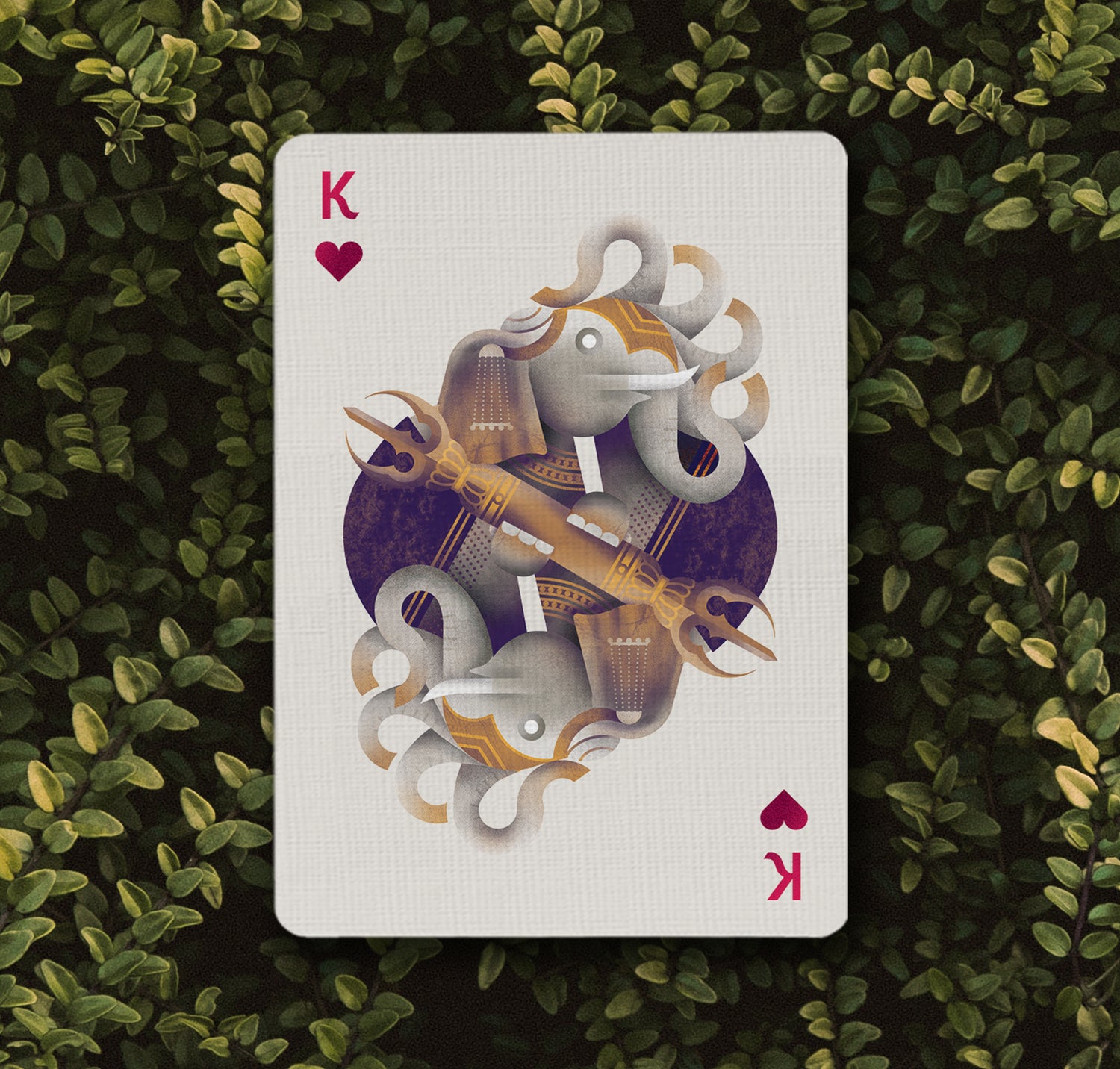
Airavata
ऐरावत : Elephant of the Clouds
High above our realm lay the peaks of heavenly Mount Meru, the home of Indra - king of the gods and lord of thunder and lightning. His mount is the majestic white elephant Airavata, the ancient king of the animal kingdom.
The origins of Airavata are disputed. Some say he emerged at the creation of the universe to guard the east, whilst his elephant brothers guarded the other cardinal directions. Together they roamed the skies to help form rain clouds to bring prosperity to the lands. Others believe Airavata was as one of the precious treasures that emerged when the benevolent gods and their immoral peers worked together to churn the ocean to retrieve the coveted nectar of immortality.
Despite his mysterious origins, he is understood to be a powerful force within the skies. Transferring water between the oceans and the clouds, he facilitates the end of droughts and flourishing of the land, thus is revered as a symbol of auspiciousness, wealth and power.
-

Image courtesy of Swaminarayan Akshardham
more detail -
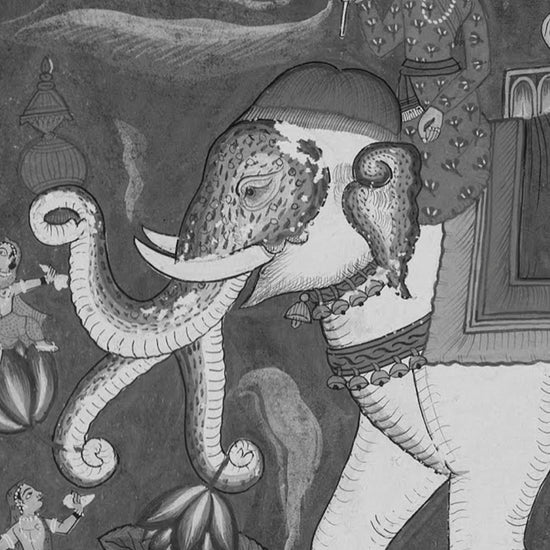
Image courtesy of LACMA
-
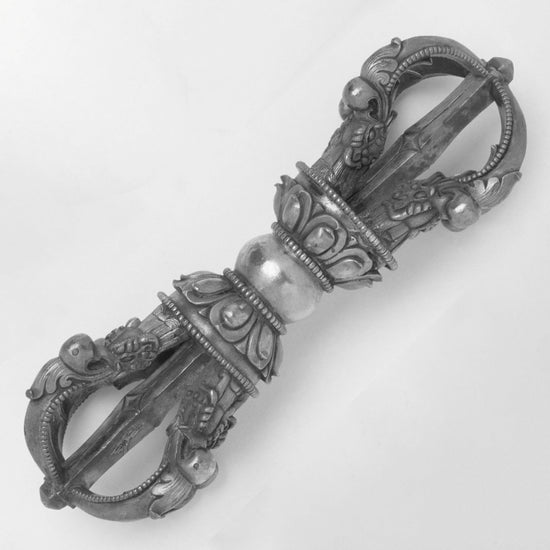
Image courtesy of Art Gallery of New South Wales
more detail -

Image courtesy of the British Library
more detail
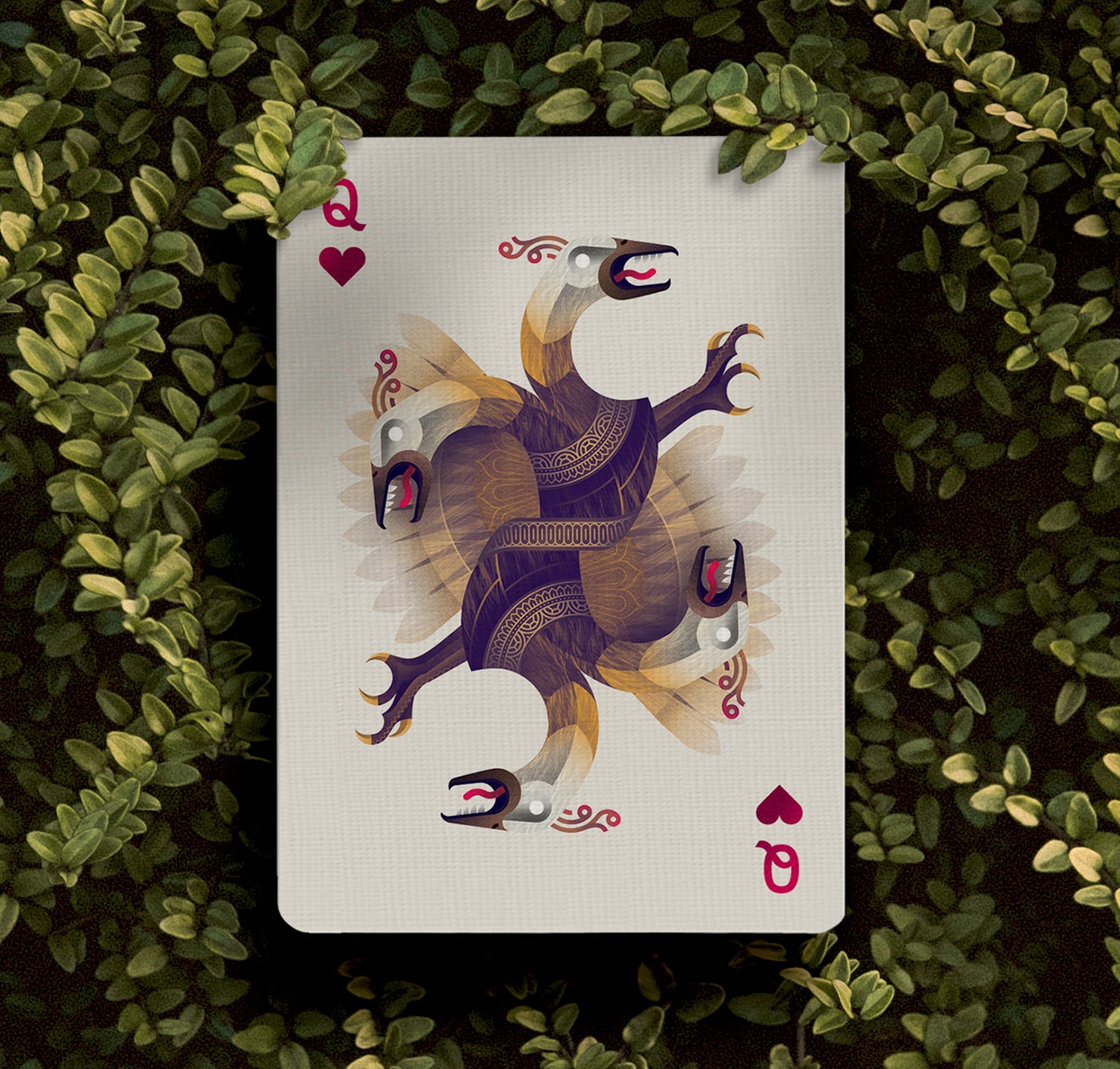
Gandaberunda
गंदाभेरुण्ड : The Foul Terror
hen the gods created Narasimha, the fierce lion-headed creature sent to destroy a demonic king, they did not predict his uncontrollable anger. Narasimha got carried away with his wrath and terrified the world on his wild rampage. To subdue the fierce creature, the gods manifested a majestic beast that was part-lion and part-bird. The creature, however, only angered him further. This growing fury caused Narasimha to transform into Gandaberunda, a terrifying, colossal two-headed bird.
The creatures fought relentlessly for eighteen days. Finally, Gandaberunda paused and noticed the destruction that had been caused in his wrath. His anger dissipated and he returned back into a peaceful, rational form to restore order and peace.
According to a particular Hindu philosophy, this story exemplifies the three innate tendencies that compose our behaviour and nature: Rajas (the quality that drives our passion and strong emotions), Tamas (the quality of chaos and imbalance) and Sattva (the quality of harmony, serenity and balance).
-

Image courtesy of Swaminarayan Akshardham
-
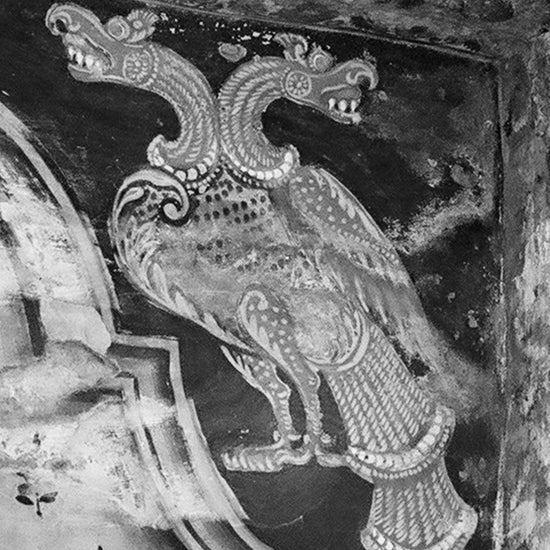
Image courtesy of Wikipedia
more detail -
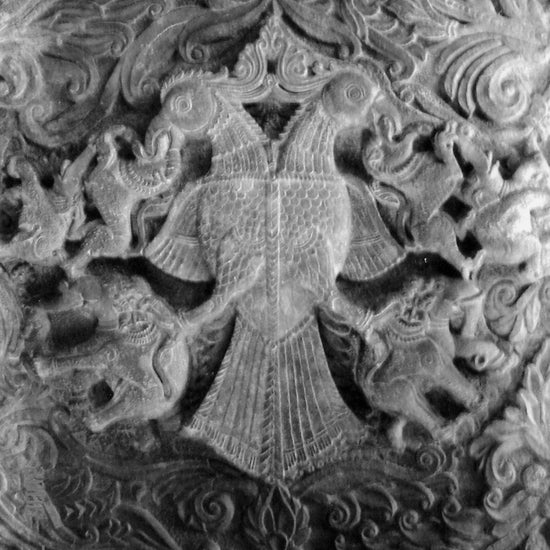
Image courtesy of Art Gallery of New South Wales
more detail -
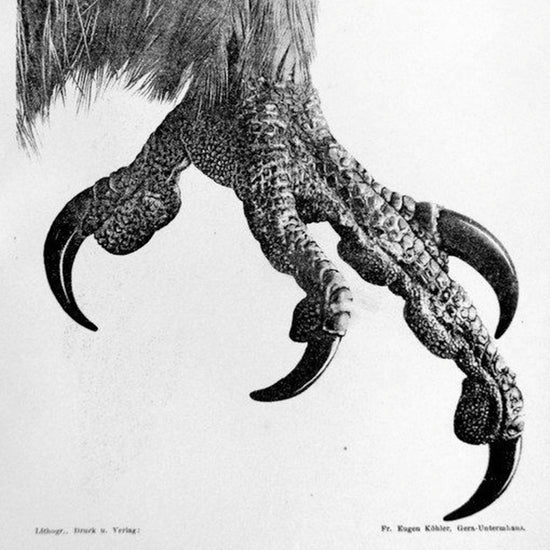
Image courtesy of Wikipedia
more detail

Garuda
गरुड़: Sworn Enemy of Snakes
Garuda grew up enslaved to a family of a thousand snakes. Long ago, his mother had lost a rigged wager with his step-mother at the cost of their freedom. His cruel snake step-brothers placed an impossible price in exchange for their liberation - the sacred nectar of immortality. With fierce determination, Garuda set off to capture the nectar. To defend this treasure, the gods attacked Garuda with all their might but nothing could sway his determination. With the prized nectar in hand, he was about to depart. However the gods, so impressed with his swift agility and impressive strength, persuaded him to stay.
The gods devised a way to coerce the sly step family into liberating Garuda and his mother without granting them the nectar, after which Garuda returned to the celestial realm to fly freely as a friend to the gods and sworn enemy to snakes.
As the personification of courage, Garuda is a symbol of determination, martial prowess and dedication.
-
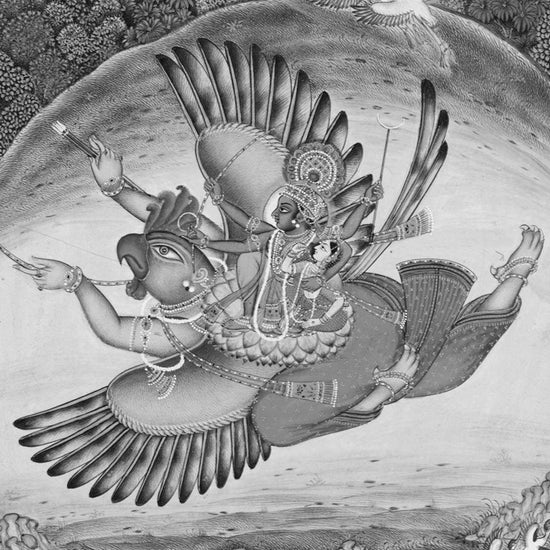
Image courtesy of the Victoria and Albert Museum.
more detail -
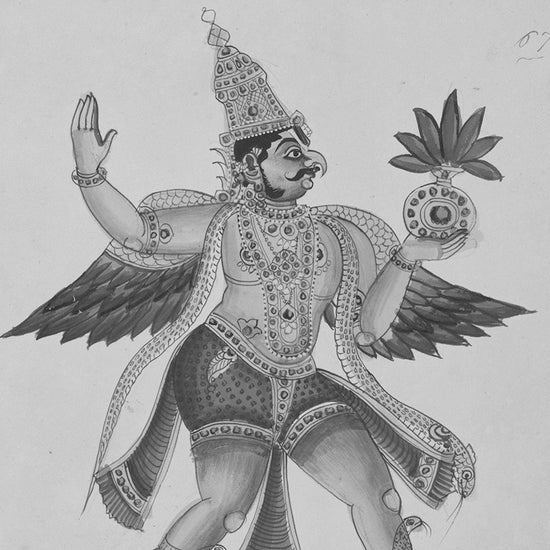
Image courtesy of the Victoria and Albert Museum.
more detail -
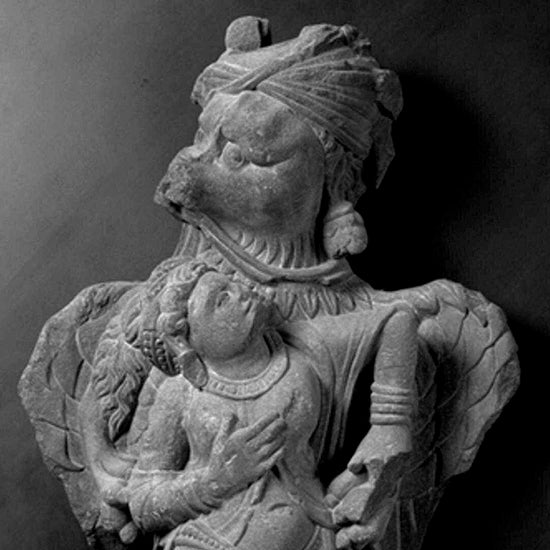
Image courtesy of the Victoria and Albert Museum.
more detail -

Image courtesy of the Victoria and Albert Museum.
more detail
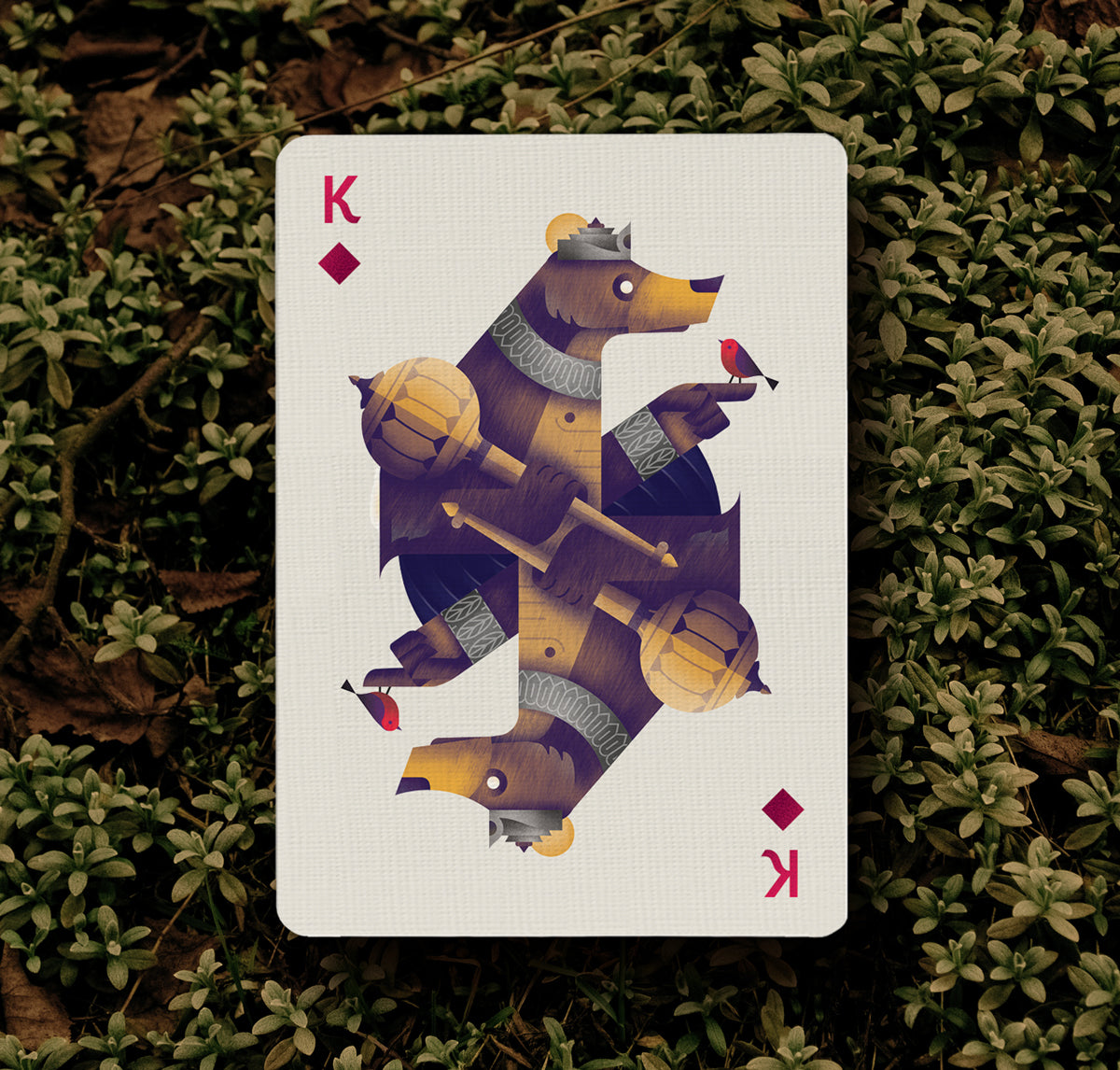
Jambavan
जाम्बवन : The wise sloth bear
There was once an exiled king, Ram, who was on a quest to rescue his wife from the demon king of Lanka. To aid Ram on his journey, the gods created Jambavan, a wise and kind sloth bear bearing the gift of long life and divine foresight. In his previous life, Jambavan was the King of the Himalayas. He was a brilliant leader, an able strategist, and formidable opponent, once taking on the demon king himself.
Together with the monkey king Sugriva, Jambavan served useful in Ram’s campaign by building a rock bridge from India to Lanka. The forest dweller led the monkey army in an arduous fight against the demon king and his minions. In battle, Ram’s brother was critically injured with little hope for recovery. Jambavan uses his ancient knowledge to identify a glowing herb from the Himalayas that saved the brother.
Jambavan is commonly portrayed as a strong, but gentle servant to the greater good. He reminds us all to slow down and to live a life of service to others, just as he did before retiring to the forest as a wise, old bear.
-
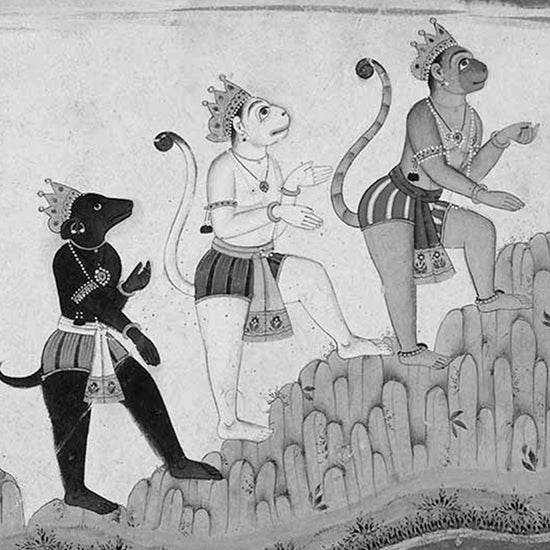
Image courtesy of Wikimedia
-
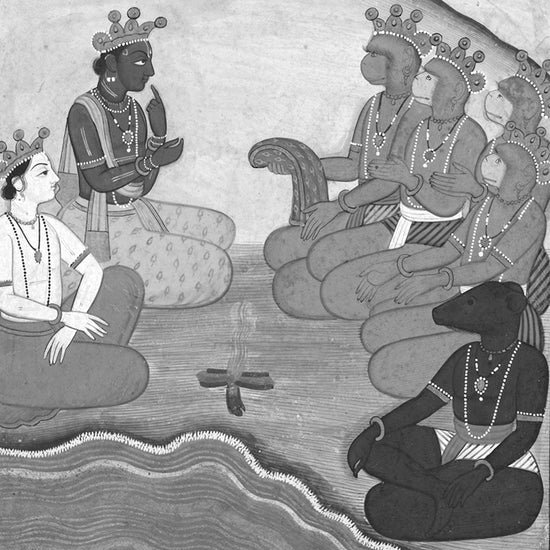
Image courtesy of National Museum, New Delhi
-
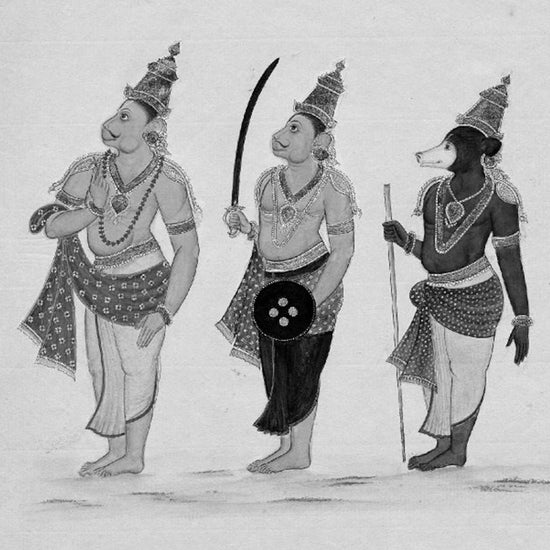
Image courtesy of British Museum
-
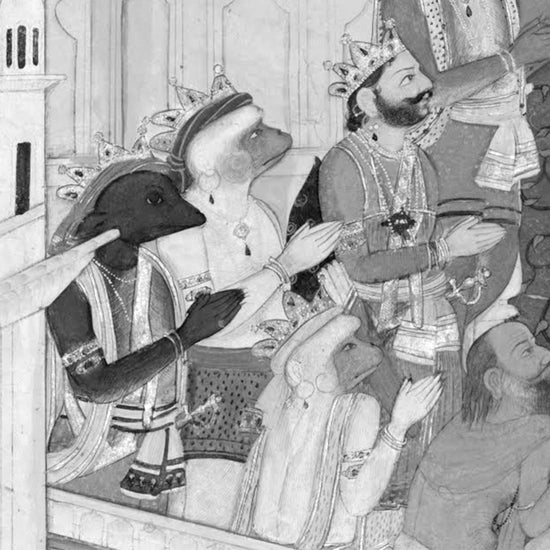
Image courtesy of Michael C. Carlos Museum, Emory University.
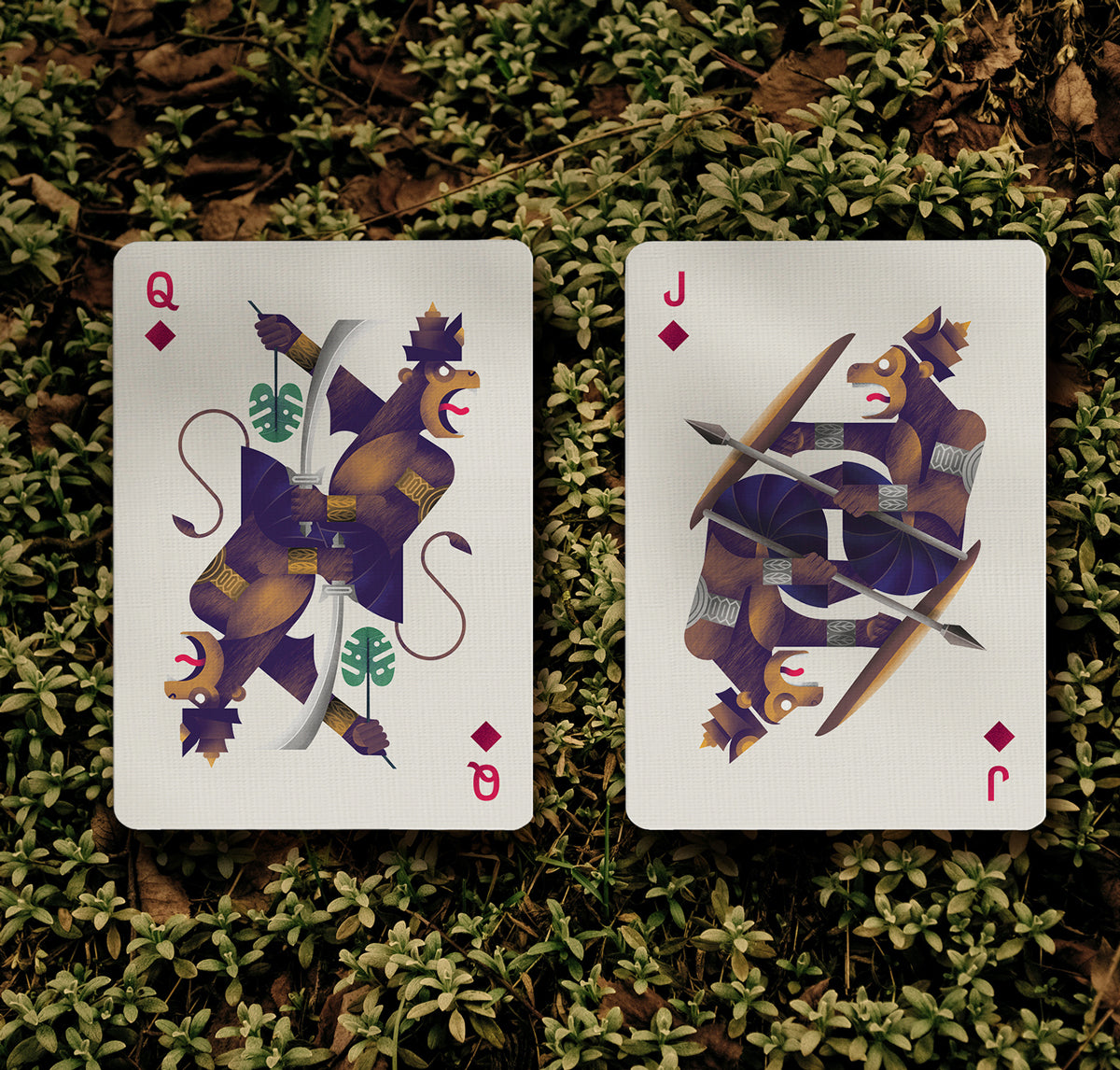
Vali & Sugriva
वाली & सुग्रीव : The dueling brothers
In a kingdom long ago ruled Vali, a monkey king with divine strength. Alongside his brother Sugriva, they maintained peace and tranquility in the forest. Though few dared to confront Vali, there arrived a demon who challenged the king. The demon immediately realized his mistake and fled. Refusing to let this challenge go, stubborn Vali followed the demon into a cave. Sugriva waited months for his brother to return, but with no sign of him he ordered the opening to the cave be blocked by a boulder, fearing the demon’s return.
Sugriva took the throne assuming his brother died, but miraculously Vali emerged victorious. Angered by his entrapment and the sight of Sugriva on the throne, Vali banished Sugriva without hearing him out and he reclaimed his place as king. In exile, Sugriva meets the hero Ram and pleads for help in defeating his brother.
Sugriva was instructed to challenge Vali to a duel, despite his immense strength. Ram emerges with his bow and fires an arrow through Vali’s chest, issuing a tragic end to a tragic misunderstanding.
-
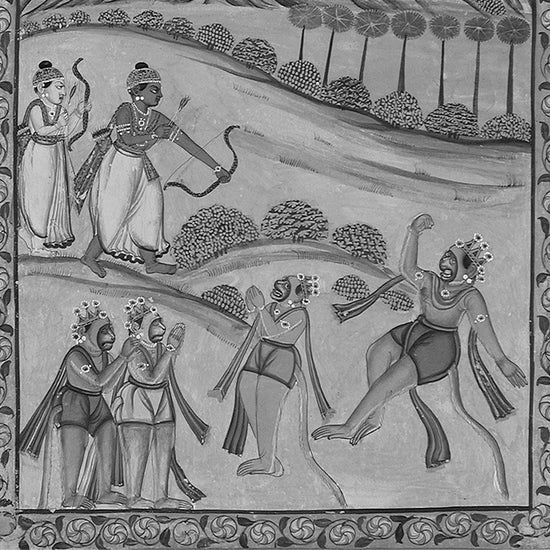
Image courtesy of LACMA
-

Image courtesy of Wikimedia
-
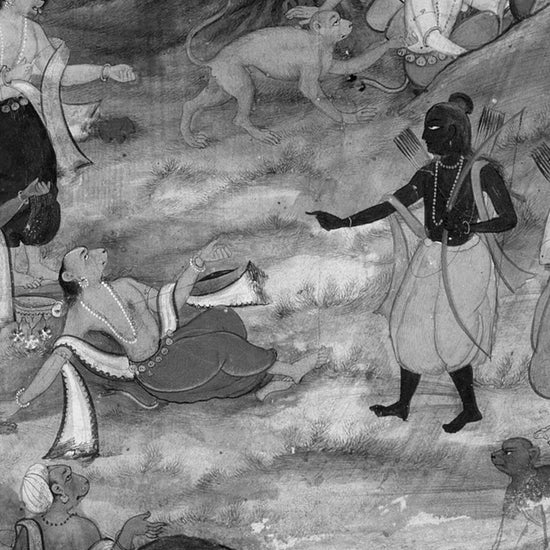
Image courtesy of LACMA
more detail -

Image courtesy of National Museum, New Delhi
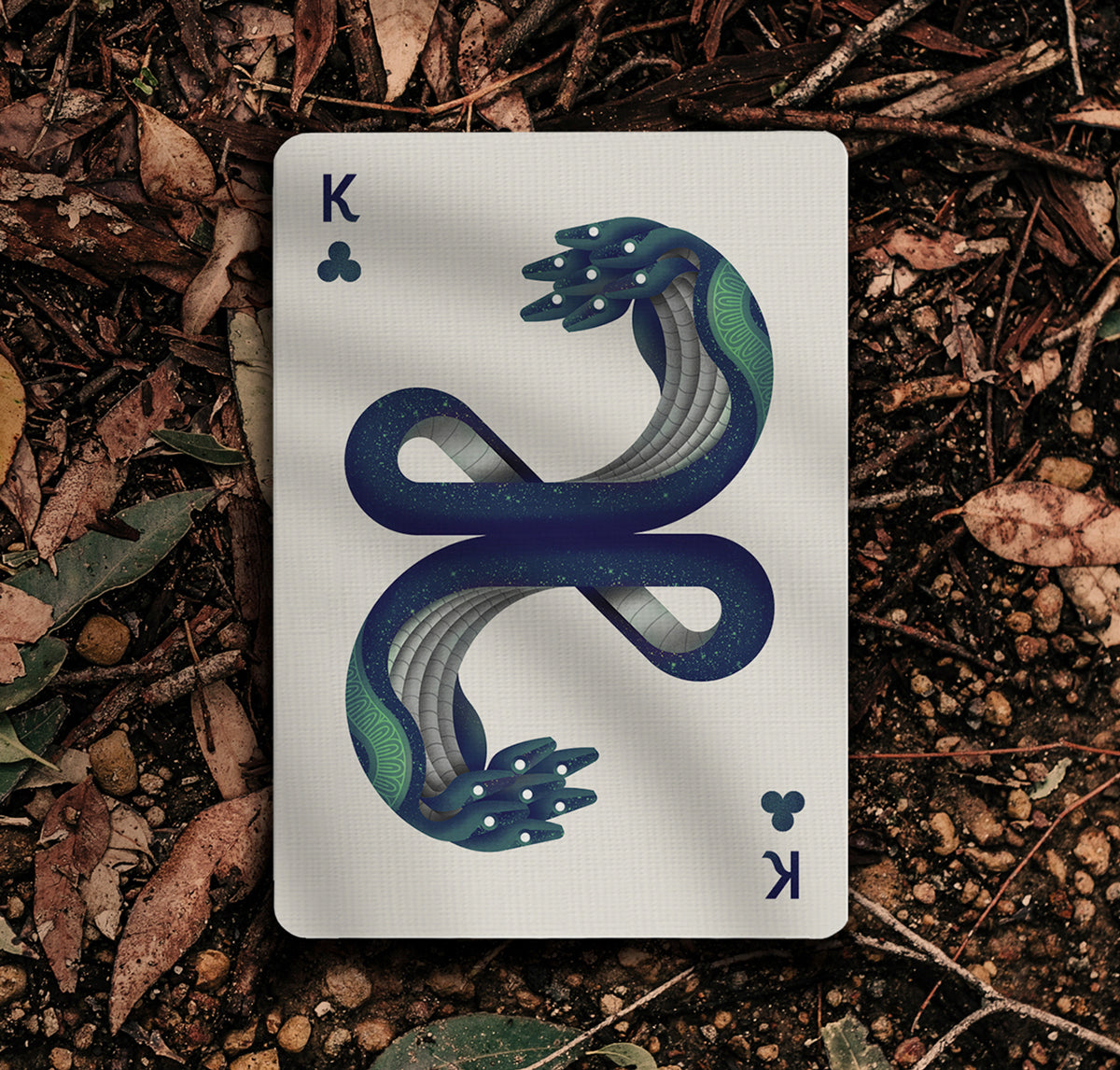
Ananta
अनंत शेष : Cosmic Serpent
As the king and ancestor of all snakes on earth, Ananta was the first born in a family of a thousand snakes. Many of his brothers were cruel, and indulged in inflicting harm on others (they even mistreated their own step-brother Garuda). Repulsed by his wicked brothers, he renounced his family and left to meditate in peace. Impressed by Ananta’s strong willpower, the gods offered him a boon. Ananta only asked to be able to control his own mind, so as to continue his ascetic lifestyle. His boon was granted, so whether he is found beneath the earth stabilizing the world or floating in the cosmic ocean, he remains eternally peaceful and unphased by changing tides.
Ananta is believed to have brought the teachings of mind control (yoga) to earth in the form of Patanjali. The name Ananta literally translates to endless and infinite, as he is all that remains in existence even after the universe is destroyed. It is said that when Ananta uncoils, time moves forward and creation takes place; when he coils back, the universe will cease to exist.
-

Image courtesy of the Victoria and Albert Museum.
more detail -
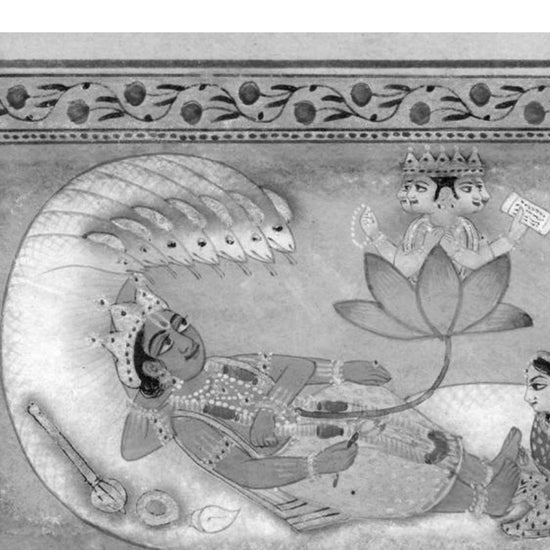
Image courtesy of the Asian Art Museum
more detail -
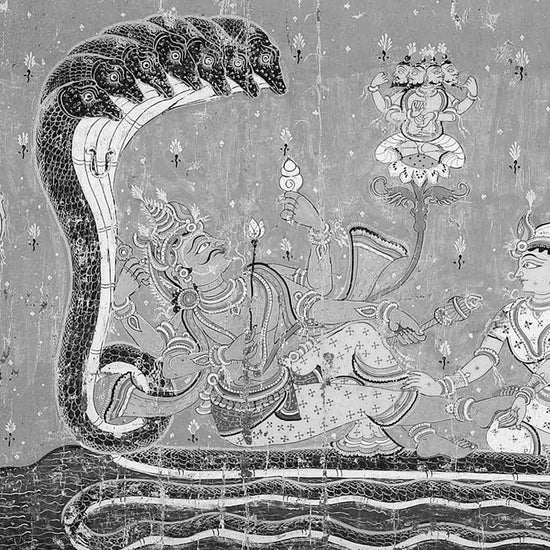
Image courtesy of the Academy of Fine Arts and Literature, New Delhi
more detail -
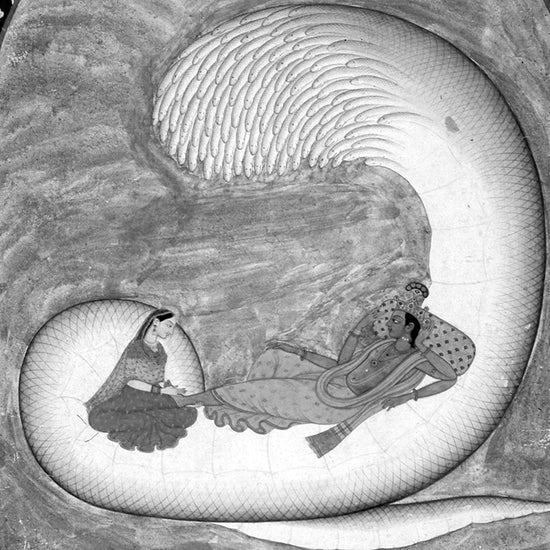
Image courtesy of The Australian National University
more detail
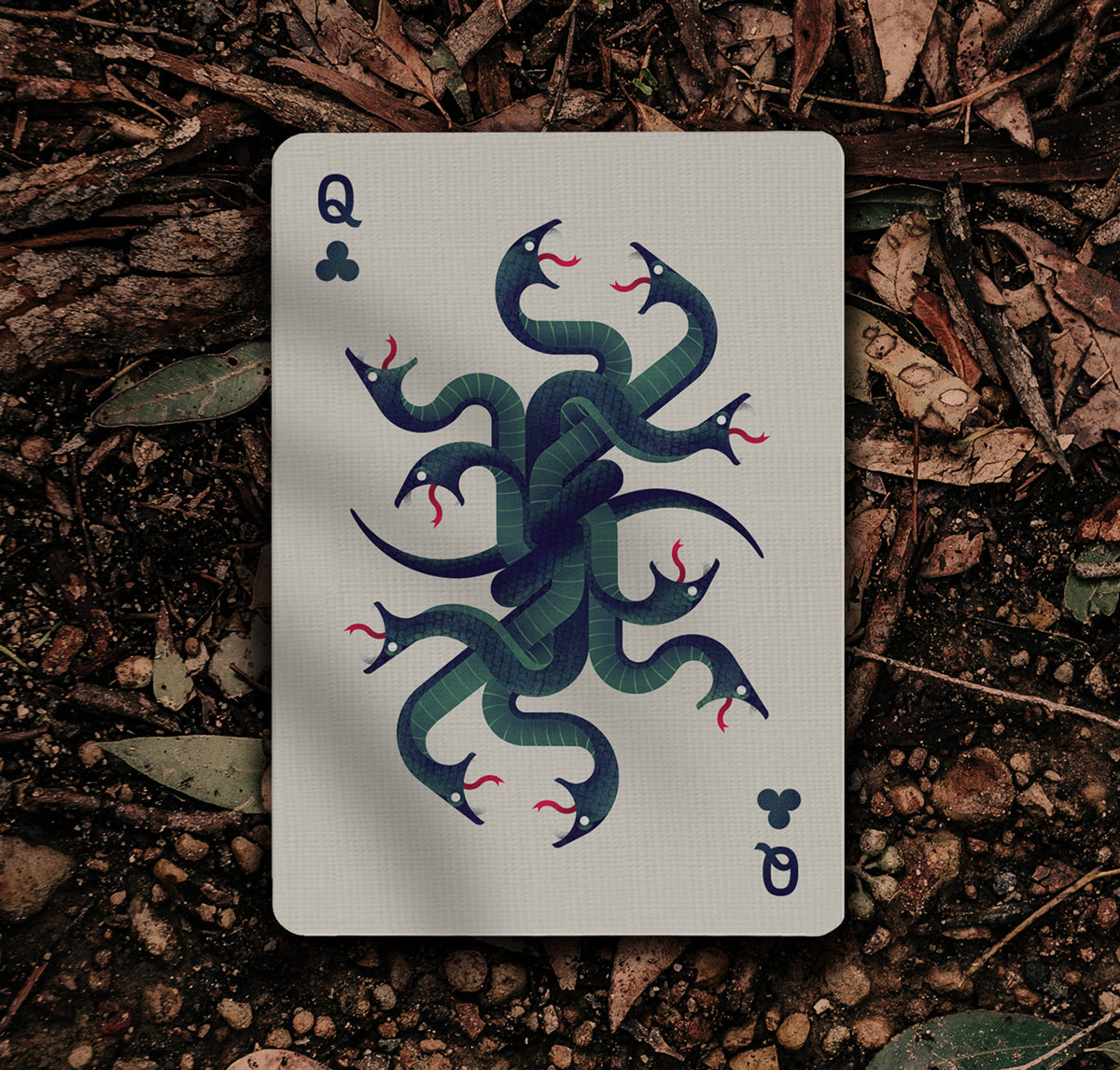
Kaliya
कालिय : The toxic serpent
Deep in the waters of the Yamuna River, the multi-headed snake Kaliya wreaked havoc near the ancient city of Vrindavan. He took refuge there since it was the only place that his nemesis Garuda could not find him. His obnoxious venom poisoned the water and air leaving but only a sole tree capable of surviving near the river bank.
Eventually Krishna steps in and triumphantly escapes the serpent’s coils, trampling Kaliya under his dancing feet. When Kaliya and his wives beg him for mercy, Krishna obliges under the condition that Kaliya stops poisoning the river and only uses his venom wisely for self-defence.
The numerous heads of Kaliya are said to symbolize our greed. When one desire gets fulfilled, another arises, like the many heads of Kaliya.
-
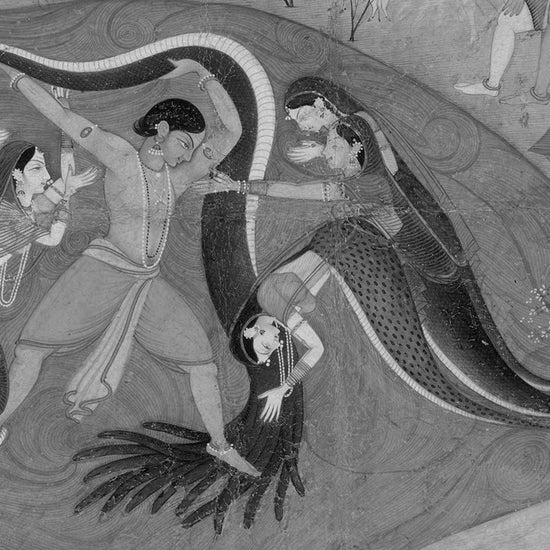
Image courtesy of The Metropolitan Museum of Art.
-
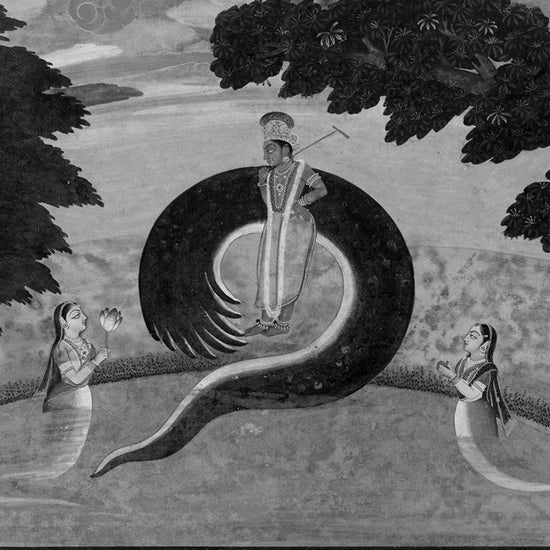
Image courtesy of the Victoria and Albert Museum.
-
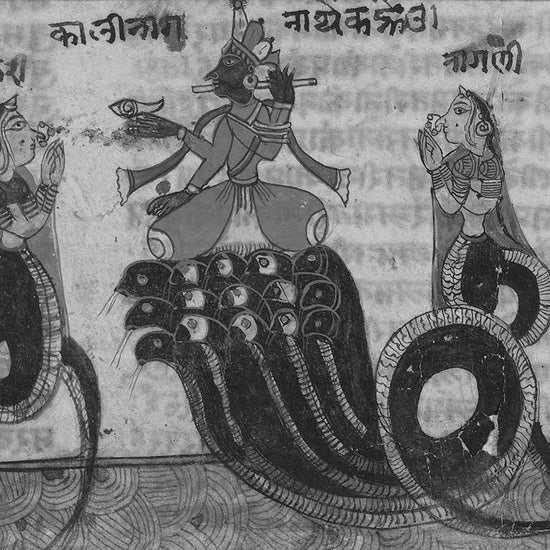
Image courtesy of the Los Angeles County Museum of Art
-
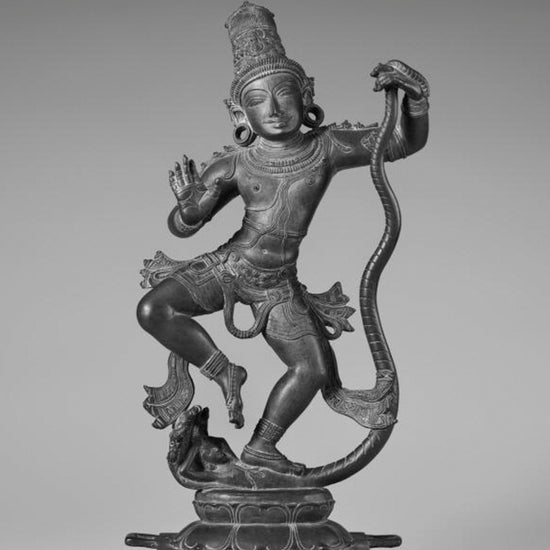
Image courtesy of the Asian Art Museum
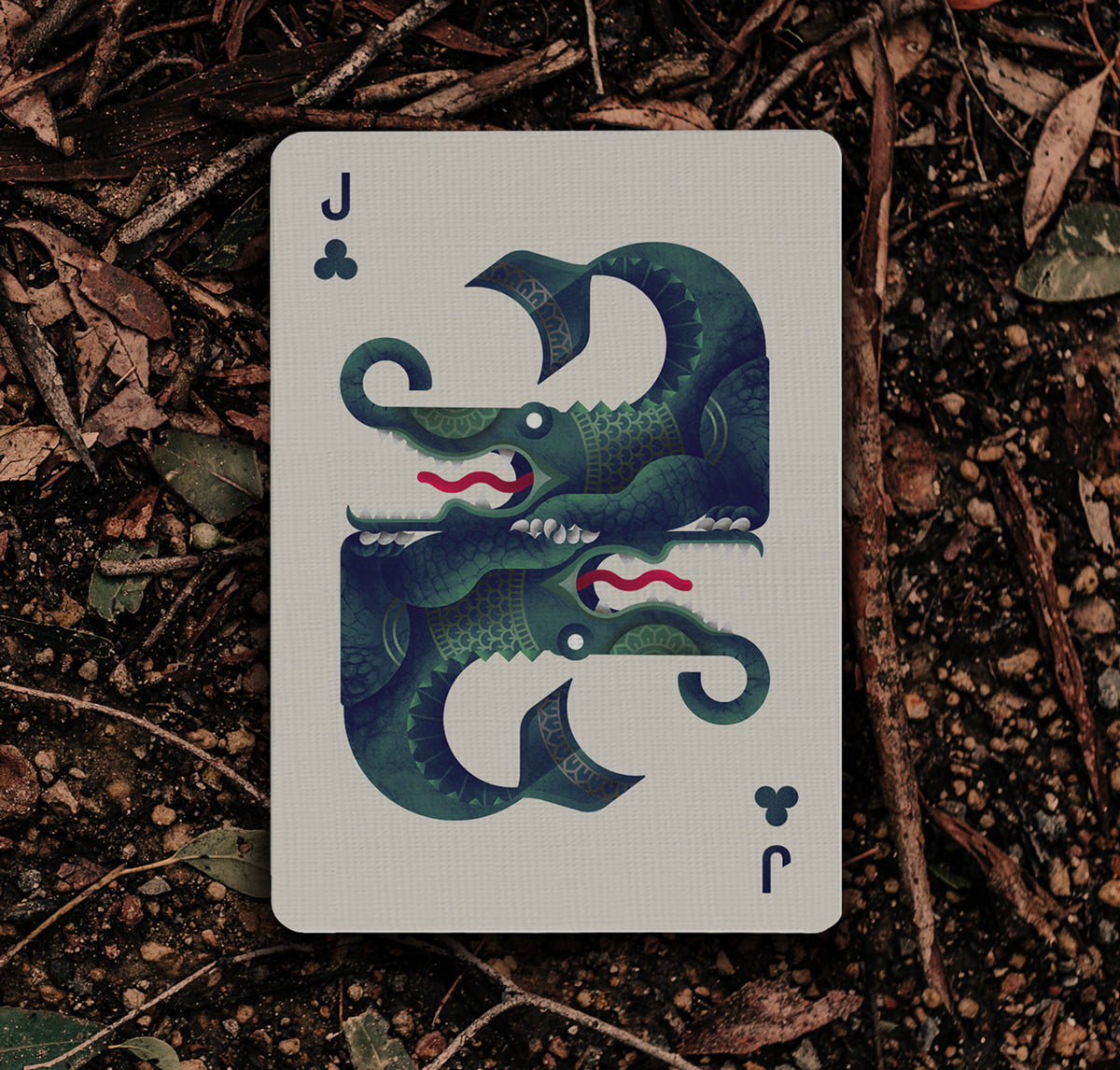
Makara
मकर : The water dragon
The waters of the land are lifelines to those who live along its shores. As a form of relentlessly moving energy, these waters have been worshipped and celebrated for the life that it sustains for flora, fauna and people alike. However, it is also feared for the unknowns of the sea and the creatures that lurk within its depths. Makara is an ancient creature that embodies the awe and fear of this powerful life force and the creation and destruction it can bring. As a half terrestrial beast, half aquatic animal, it is a form created from elusive glimpses of river dolphins, elephants, crocodiles, fishes and snakes that have been sighted in rivers or out in the sea. As a symbol of life that is both feared and revered, Makara is considered the guardian of thresholds and gateways, serving as the protector of order and an essential sign of bounty.
Symbols of Makara can be found across Asia, as the most commonly recurring creature in Hindu and Buddhist temples. It can be sighted spewing water as a gargoyle at the corner of roofs, or at archways, staircases and entryways protecting the rooms beyond.
-
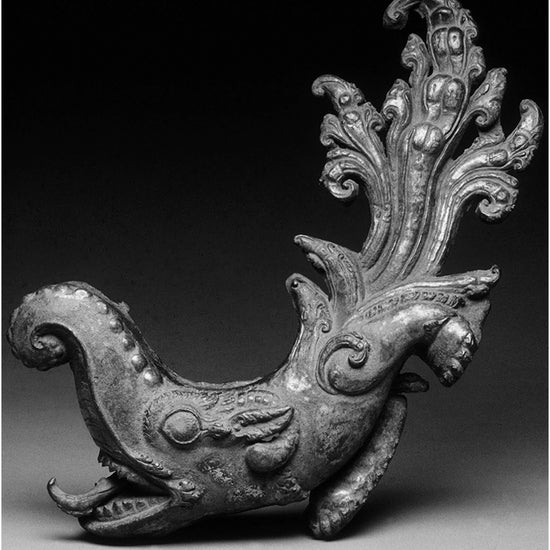
Image courtesy of the Los Angeles County Museum of Art
-
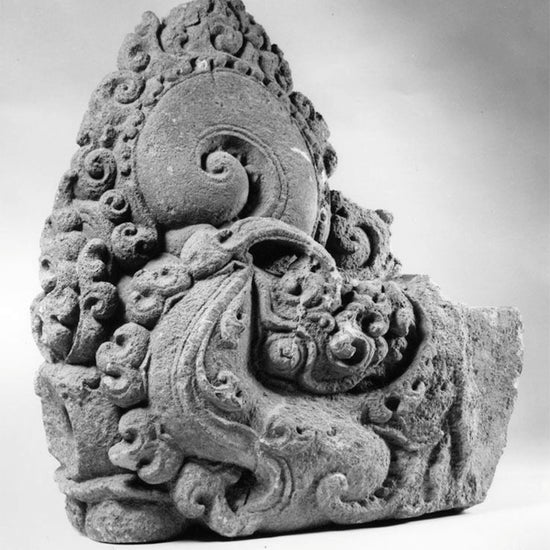
Image courtesy of The Metropolitan Museum of Art.
-
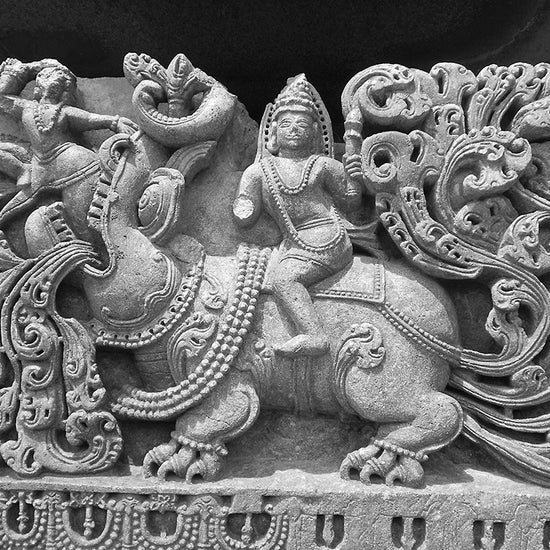
Image courtesy of Wikipedia
-
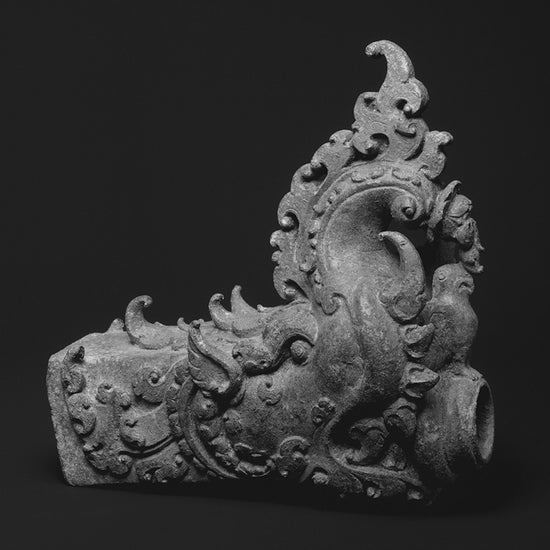
Image courtesy of The Metropolitan Museum of Art.
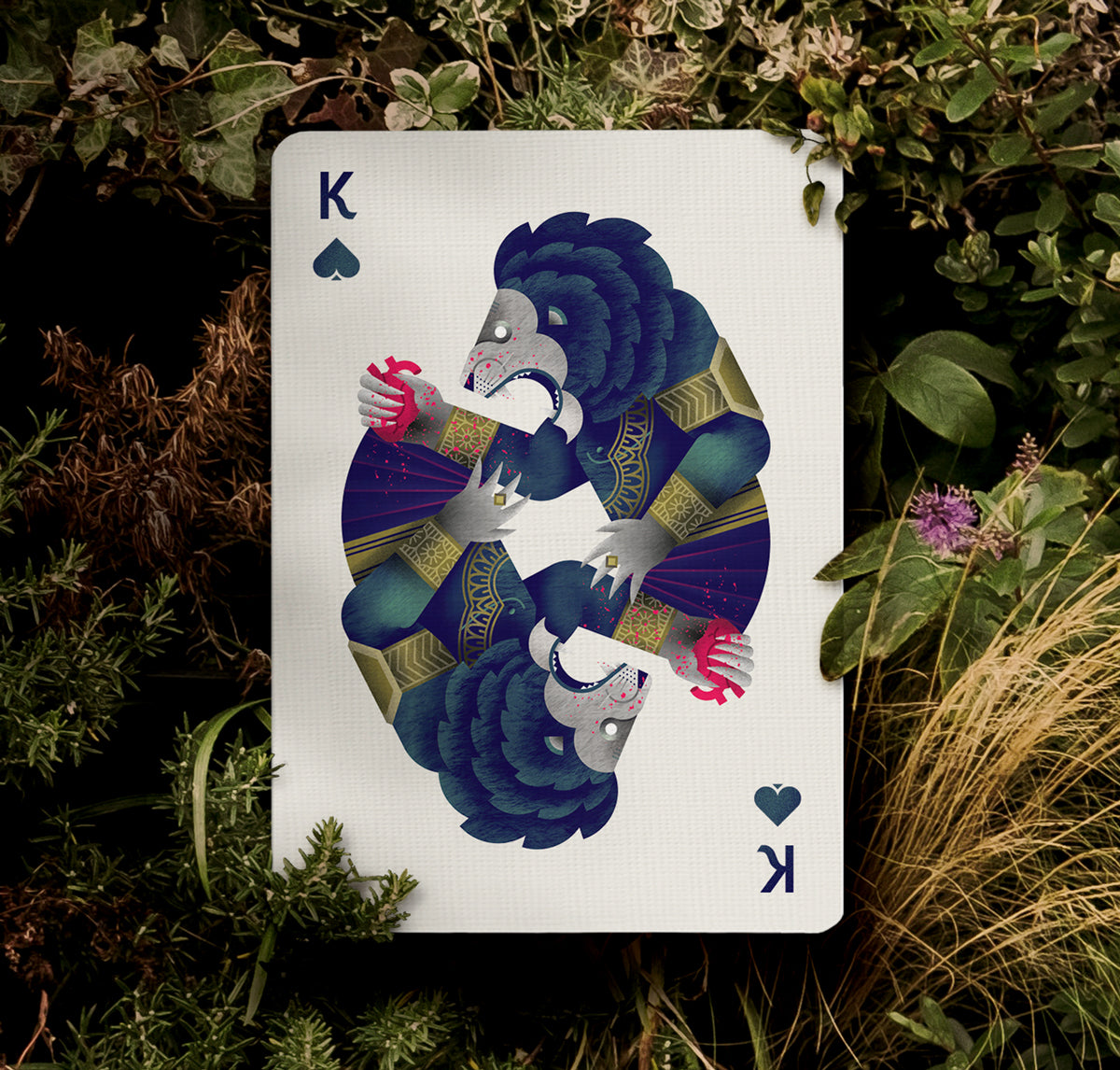
Narasimha
नरसिंह : Destroyer of Tyrants
A vengeful king once took many years of austere penance to gain special powers. He was upset at the gods for the death of his brother, so he requested a unique set of conditions that could protect him from death. His wishes were granted by the gods: he would not meet his death by either man or animal, by night or day, indoors or outdoors, and no weapon could kill him.
With the promise of invincibility, the king became proud and tyrannical. He believed himself to be the most powerful and important being so persecuted those who did not worship him. To punish the insolent king, the gods created Narasimha. As part man and part lion, Narasimha emerges at twilight from a pillar in the courtyard of the king’s palace. He attacks the king only with his fierce nails and ruthlessly tears the king apart.
As a champion against tyrants who abuse power, Narasimha embodies our capacity for creative resistance, hope against the odds, and triumph over persecution.
-
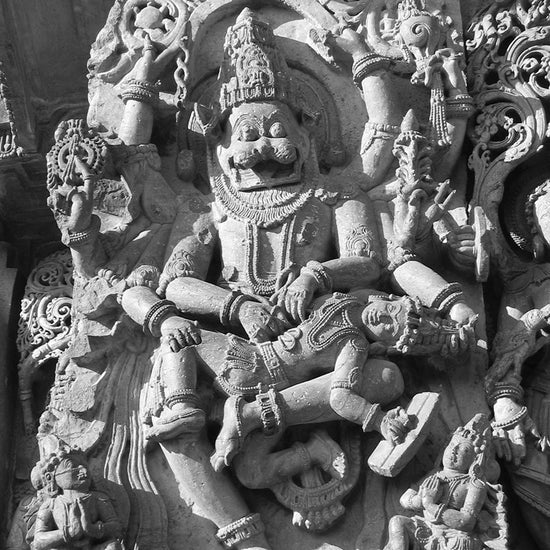
Image courtesy of Wikimedia
-
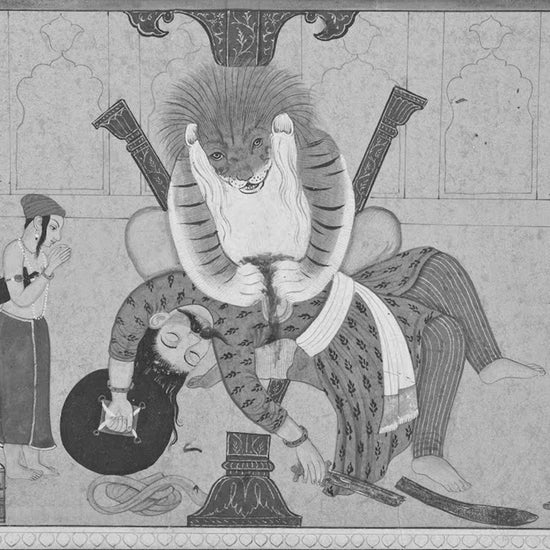
Image courtesy of the Los Angeles County Museum of Art
-
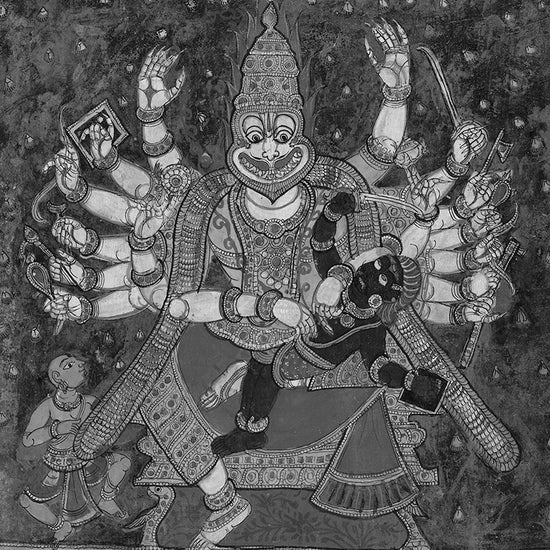
Image courtesy of British Library
-
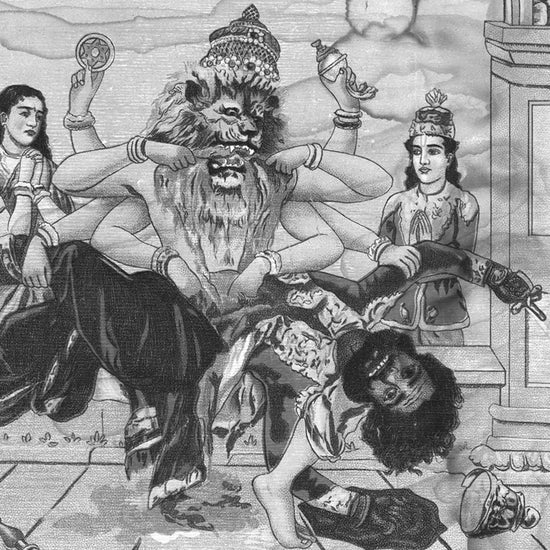
Image courtesy of The Hemamalini and Ganesh Shivaswamy collection
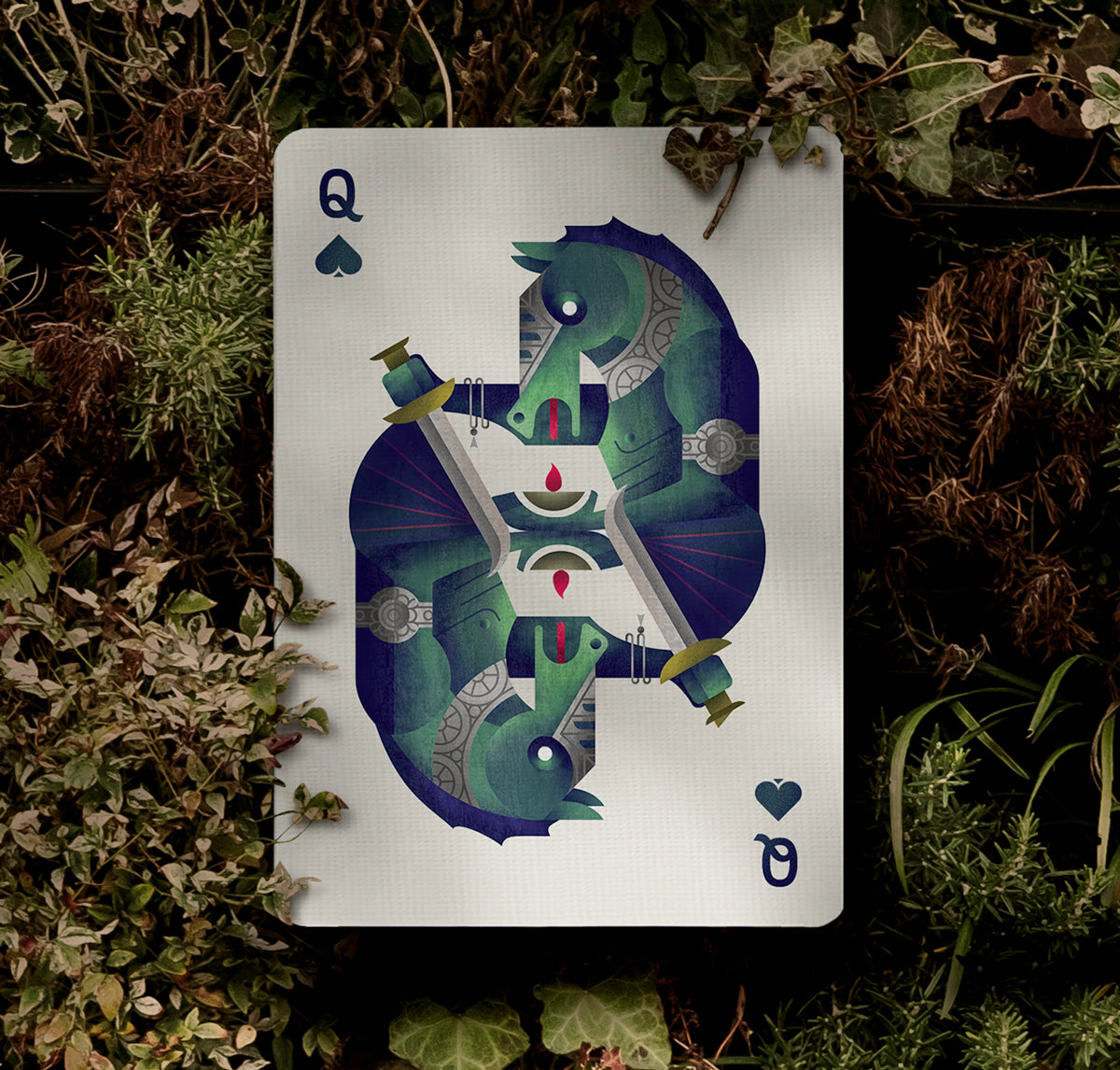
Hayagriva
हयग्रीव : The horse-headed one
By way of a great meditation, a horse-headed demon named Hayagriva was granted a boon from the gods. Knowing immortality was impossible to request, he cleverly asked that he could only be killed by another horse-headed Hayagriva.
The boon instilled in him a sense of being invincible and as a result he started harassing the gods, realising that they could not kill him. The gods turned to Lord Vishnu for help for his ability to regain control over the spread of evil. However, Vishnu was in a deep state of meditation, sitting in a cross-legged yoga pose with his head resting on a bow. Unable to rouse him from his deep concentration, the gods sent a troop of termites to gnaw at the bow that Vishnu was resting on. The string snapped and lashed out with such force that it severed his head from his body.
The gods used this unfortunate circumstance to their advantage. They attached a horse’s head onto Vishnu’s body and called him Hayagriva. The two Hayagrivas went into battle and after a long campaign, the demon was killed.
The worship of Vishnu’s Hayagriva avatar dates back to 2,000 BCE as the god of wisdom and knowledge. The name Hayagriva literally translates to horse (haya) neck (griva).
-
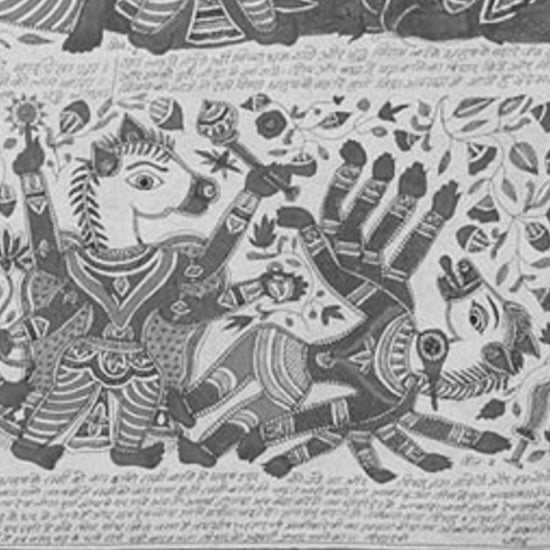
Image courtesy of Exotic India
-
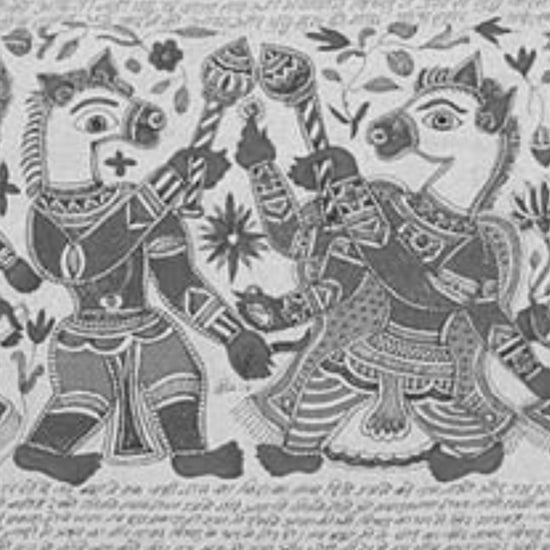
Image courtesy of Exotic India
-
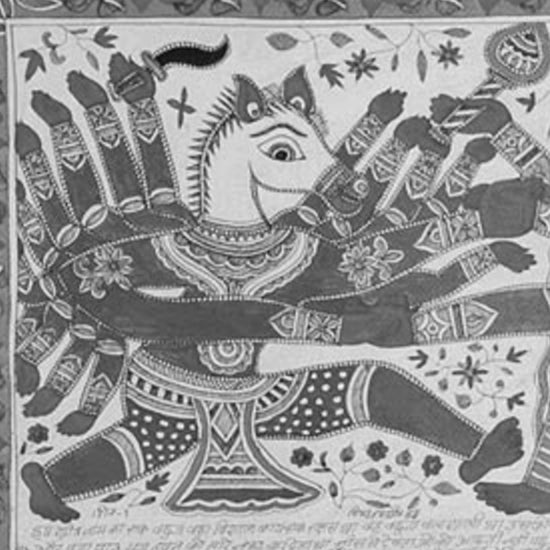
Image courtesy of Exotic India
-
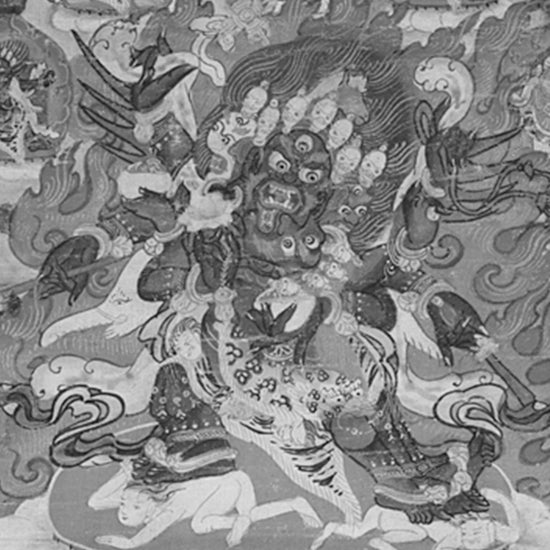
Image courtesy of the Los Angeles County Museum of Art
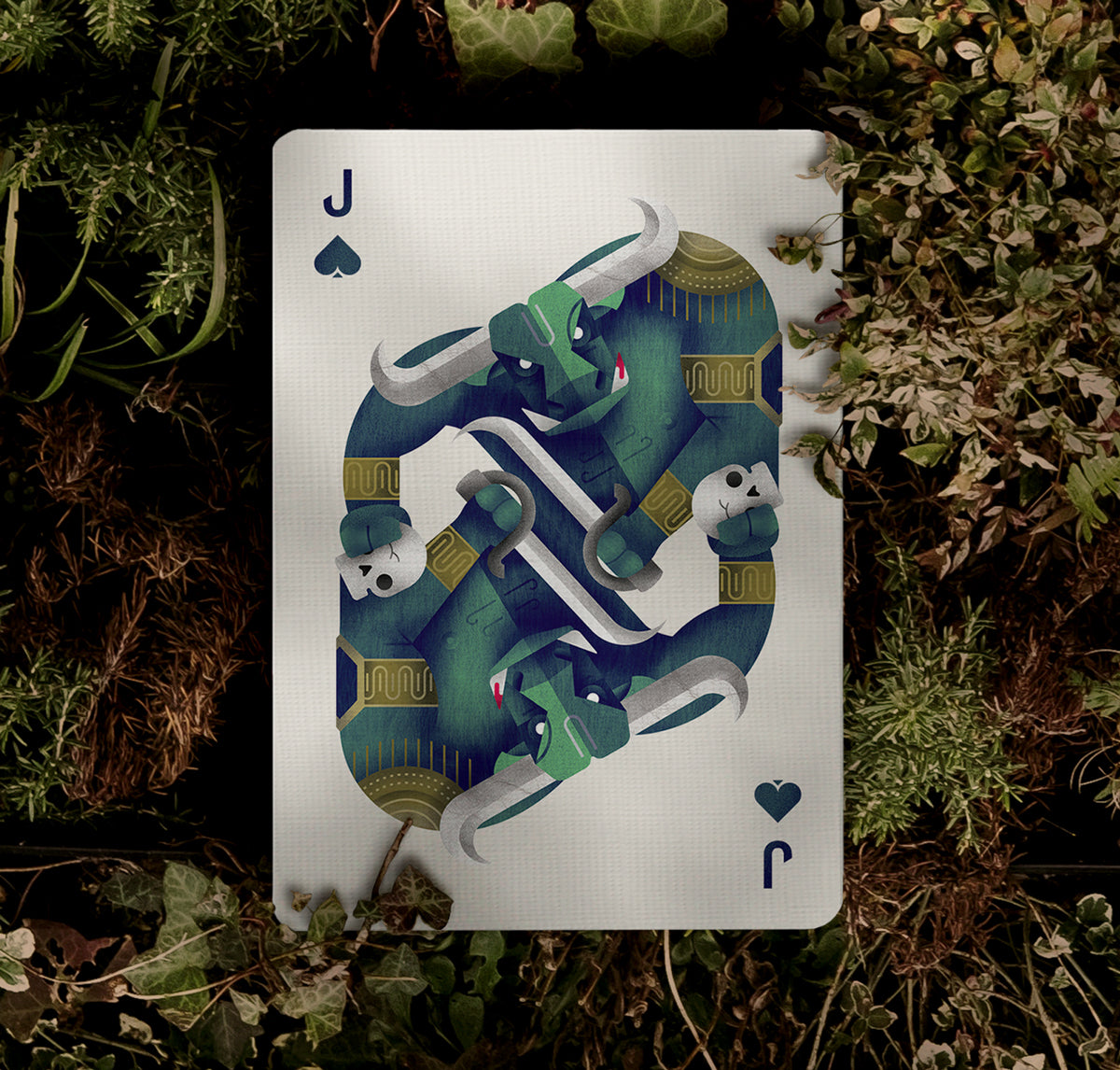
Mahishasura
महिषासुर : Demon Buffalo King
Legends describe Mahishasura as an ambitious buffalo-headed king who after years of penance, was granted a boon that no man, god, demon or beast, would ever kill him. The thought of evading death fed his ambition and arrogance, as he waged war on the three realms of existence. The gods, left evicted from their celestial realm, combined their powers together to forge a warrior goddess, Durga. They equipped her many arms with their most powerful weapons. Astride a fierce tiger, she sought out the unstoppable king.
Upon seeing her, Mahishasura scoffed at the idea that a woman could even consider defying him. However the goddess showed no mercy - she fought him for ten days until he finally met his end with a decapitating strike to the head.
The legend of Mahishasura cautions us against chauvinistic behaviour, the greed of our ambitions and the false sense of security rooted in arrogance.
-
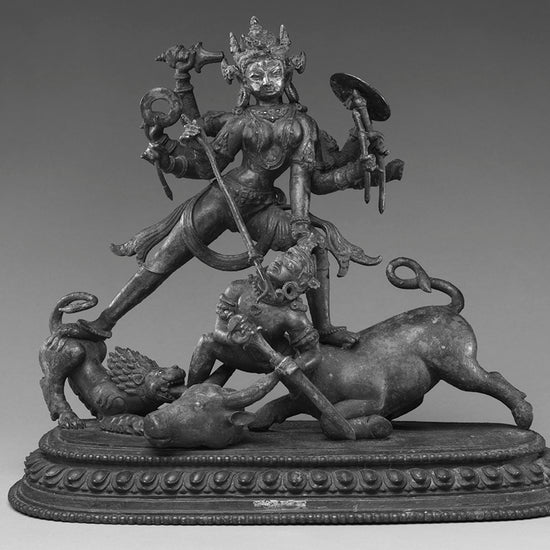
Image courtesy of The Metropolitan Museum of Art.
-

Image courtesy of Wikipedia
-
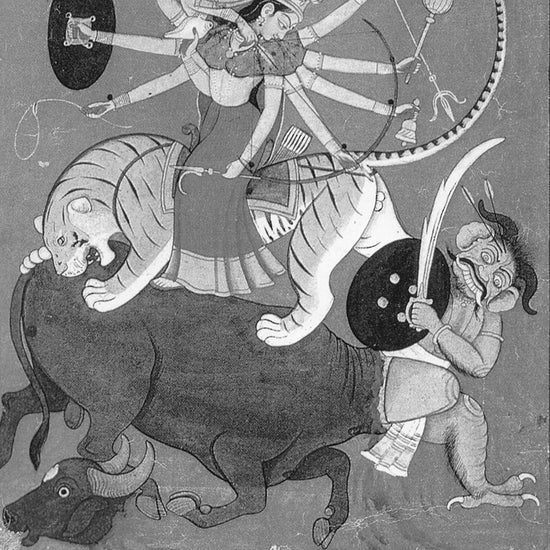
Image courtesy of Wikipedia
-

Image courtesy of Exotic India
EXCERPT FROM AN ANCIENT TEXT
तमापतन्तं तरसा विषायुध:
प्रत्यभ्ययादुत्थितनैकमस्तक: ।
दद्भि: सुपर्णं व्यदशद् ददायुध:
करालजिह्वोच्छ्वसितोग्रलोचन: ॥ ६ ॥
As Garuḍa swiftly fell upon him, Kāliya, who had the weapon of poison, raised his numerous heads to counterattack. Showing his ferocious tongues and expanding his horrible eyes, Kāliya then bit Garuḍa with the weapons of his fangs.
IN ADDITION TO THE TALES PASSED DOWN BY OUR ANCESTORS
References
Airavata ऐरावत
- Doniger, Wendy. "Indra". Encyclopedia Britannica, 10 Sep. 2022, https://www.britannica.com/topic/Indra. Accessed November 12, 2018.
- Vajra. https://en.wikipedia.org/wiki/Vajra. Accessed November 12, 2018.
- Wright, Colin. “Indra Sabha - Indra & Pillars [Sculpture of Indra in Indra Sabha Jain Cave Temple (Cave Xxxii), Ellora.].” The British Library - The British Library, The British Library, 12 Sept. 2008, https://www.bl.uk/onlinegallery/onlineex/apac/photocoll/i/019pho000000040u00108000.html.
Gandaberunda गंदाभेरुण्ड
- “Gandaberunda.” Wikipedia, Wikimedia Foundation, 7 Feb. 2018, https://en.wikipedia.org/wiki/Gandaberunda.
- Kumar, T R Sathish. “Gandaberunda: Flights of the Two-Headed Bird.” Deccan Herald, DH News Service, 23 Nov. 2019, https://www.deccanherald.com/spectrum/spectrum-top-stories/gandaberunda-flights-of-the-two-headed-bird-772554.html.
- Chopra, Praveen. Vishnu’s Mount: Birds In Indian Mythology And Folklore. Notion Press, 2017.
Garuda गरुड़
- “Garuda.” Wikipedia, Wikimedia Foundation, 7 Feb. 2018, https://en.wikipedia.org/wiki/Garuda.
- “The Hindu Deities Krishna and Satyabhama Riding Garuda.” Asian Art Museum Online Collection, Asian Art Museum Chong-Moon Lee Center for Asian Art and Culture, http://asianart.emuseum.com/view/objects/asitem/items$0040:11001.
- “Vajrapani Trampling Snakes.” Google Arts & Culture, Rubin Museum of Art, https://artsandculture.google.com/asset/vajrapani-trampling-snakes/xAG3NCVcUXmE3w.
Jambavan जाम्बवन
- “Jambavan.” Wikipedia, Wikimedia Foundation, 7 Feb. 2018, https://en.wikipedia.org/wiki/Jambavan
- Krishna, Nanditha. “Jambavan.” Sacred Animals of India, Penguin Group Australia, Scoresby.
- “Masks, Other Worlds.” Google Arts & Culture, Crafts Museum, https://artsandculture.google.com/story/eAXh-66YoqD6KA
Vali वाली
- Krishna, Nanditha. “Vali & Sugriva.” Sacred Animals of India, Penguin Group Australia, Scoresby.
- “Rama Meets with the Monkey King Sugreeva.” Google Arts & Culture, National Museum, New Delhi, https://artsandculture.google.com/story/mAUxs16JDT0bDA.
- “Lakshmana Reminds Monkey King Sugreeva of His Duty To Search For Sita.” Google Arts & Culture, National Museum, New Delhi, https://artsandculture.google.com/story/EgUxP72cDn7ByQ
Sugriva सुग्रीव
- Krishna, Nanditha. “Vali & Sugriva.” Sacred Animals of India, Penguin Group Australia, Scoresby.
- “Rama Meets with the Monkey King Sugreeva.” Google Arts & Culture, National Museum, New Delhi, https://artsandculture.google.com/story/mAUxs16JDT0bDA.
- “Lakshmana Reminds Monkey King Sugreeva of His Duty To Search For Sita.” Google Arts & Culture, National Museum, New Delhi, https://artsandculture.google.com/story/EgUxP72cDn7ByQ
Ananta अनंत शेष
- “Miniature Hindu shrine with Vishnu sleeping on the cosmic ocean.” Asian Art Museum Online Collection, Asian Art Museum Chong-Moon Lee Center for Asian Art and Culture, http://asianart.emuseum.com/view/objects/asitem/items$0040:10891
- “Shesha.” Wikipedia, Wikimedia Foundation, 7 Feb. 2018, https://en.wikipedia.org/wiki/Shesha
- “Vishnu asleep on the serpent in the cosmic ocean.” Asian Art Museum Online Collection, Asian Art Museum Chong-Moon Lee Center for Asian Art and Culture, http://asianart.emuseum.com/view/objects/asitem/items$0040:11019
Kaliya कालिय
- “First Generation after Manaku and Nainsukh: Krishna Subduing Kaliya, the Snake Demon: Folio from a Bhagavata Purana Series: Northern India, Garwhal, Himachal Pradesh.” The Metropolitan Museum of Art, https://www.metmuseum.org/art/collection/search/37946.
- “Krishna overcoming the serpent Kaliya.” Asian Art Museum Online Collection, http://asianart.emuseum.com/view/objects/asitem/items$0040:11056
Makara मकर
- Beer, Robert. The Handbook of Tibetan Buddhist Symbols. Shambhala, 2003.
- “Korawakgala.” Wikipedia, Wikimedia Foundation, 13 Dec. 2022, https://en.wikipedia.org/wiki/Korawakgala.
- “Makara.” Crow Collection, https://crowcollection.org/gallery-item/makara/.
- “Makara.” Wikipedia, Wikimedia Foundation, 7 Feb. 2023, https://en.wikipedia.org/wiki/Makara#Sri_Lankan_iconography.
Mahishasura महिषासुर
- Deogharia, Jaideep. “Asur Tribals Mourn 'Martyr' Mahishasur.” The Times of India, Ranchi News, 11 Oct. 2013, https://timesofindia.indiatimes.com/city/ranchi/asur-tribals-mourn-martyr-mahishasur/articleshow/23927688.cms.
- “Goddess Durga Slaying the Demon.” Exotic India Art, https://www.exoticindiaart.com/product/paintings/goddess-durga-slaying-demon-hn41/.
- “The Eighteen-Armed Mahishasura-Mardini.” Exotic India Art, https://www.exoticindiaart.com/product/paintings/eighteen-armed-mahishasura-mardini-hl71/.
Narasimha नरसिंह
- “Narasimha.” Wikipedia, Wikimedia Foundation, 7 Feb. 2018, https://en.wikipedia.org/wiki/Narasimha.
- “The Hindu deity Vishnu in the form of the man-lion Narasimha.” Asian Art Museum Online Collection, Asian Art Museum Chong-Moon Lee Center for Asian Art and Culture, http://asianart.emuseum.com/view/objects/asitem/items$0040:11707
- “The Hindu deity Narasimha.” Asian Art Museum Online Collection, Asian Art Museum Chong-Moon Lee Center for Asian Art and Culture, http://asianart.emuseum.com/view/objects/asitem/items$0040:11080
Hayagriva हयग्रीव
- Babu, D. Sridhara, and M. Srimannarayana Murti. Hayagrīva: The Horse-Headed Deity in Indian Culture. Sri Venkateswara University Oriental Research Institute, 1990.
- Brown, Cheever Mackenzie. “Horsing Around with Vishnu.” The Triumph of the Goddess the Canonical Models and Theological Visions of the devī-bhāgavata purāṇa, NetLibrary, Inc., Boulder, CO, 1999.
- “Hayagriva.” Wikipedia, Wikimedia Foundation, 4 Feb. 2023, https://en.wikipedia.org/wiki/Hayagriva.










































